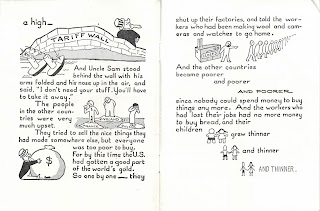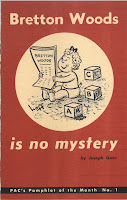 In his 1657 Lettres Provinciales, French philosopher and mathematician Blaise Pascal quipped: “I would have written a shorter letter, but I did not have the time.” This pithy expression captures the genius behind The Story of Bretton Woods (a topic we covered ourselves less graphically a few weeks ago). Equipped with 20 illustrated pages and simple vocabulary, this WWII-era pamphlet informed American children about the 1944 Bretton Woods Conference. The conference’s express purpose was to create a stable financial order for the postwar world. Explaining these ideas at any length is notable, but this pamphlet’s concision sets it apart.
In his 1657 Lettres Provinciales, French philosopher and mathematician Blaise Pascal quipped: “I would have written a shorter letter, but I did not have the time.” This pithy expression captures the genius behind The Story of Bretton Woods (a topic we covered ourselves less graphically a few weeks ago). Equipped with 20 illustrated pages and simple vocabulary, this WWII-era pamphlet informed American children about the 1944 Bretton Woods Conference. The conference’s express purpose was to create a stable financial order for the postwar world. Explaining these ideas at any length is notable, but this pamphlet’s concision sets it apart.For five cents per copy, parents could educate their children about “the kind of world we make for them now.” Yet, we suspect The Story of Bretton Woods had an ulterior motive. Stocked with the twin virtues of brevity and clarity, it could effectively mobilize the voting age population to support the conference’s legislation. We are uncertain whether the pamphlet targeted adults, but its educational value is clear 70 years later.
 To see The Story of Bretton Woods, ask for ML-3, box 108, folder 6. As bonus there is another example of Bretton Woods simply explained for lay people, Bretton Woods is no Mystery.
To see The Story of Bretton Woods, ask for ML-3, box 108, folder 6. As bonus there is another example of Bretton Woods simply explained for lay people, Bretton Woods is no Mystery.Posted for Drew Leonard '19


